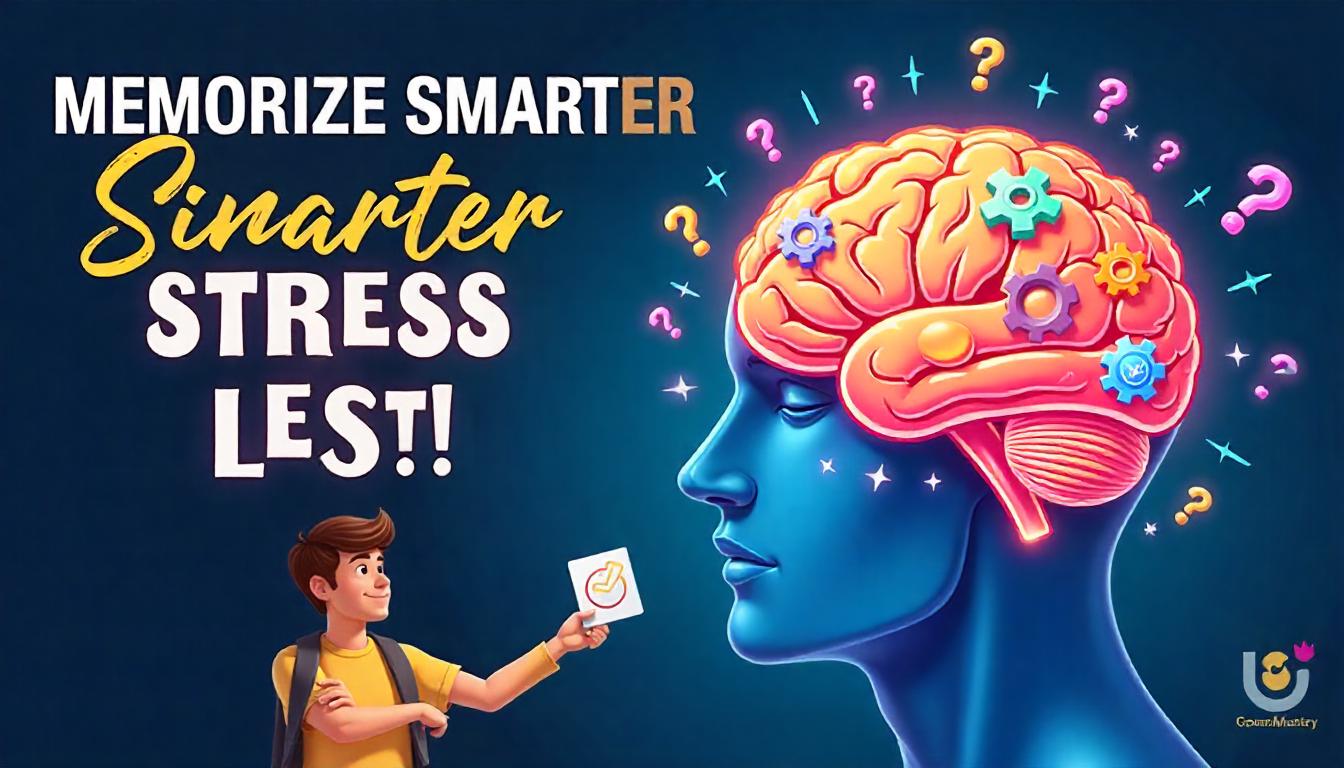As a student, committing content to memory isn’t simply an ancillary activity—it is usually one’s entire workload. But what if you could learn more, retain information for longer, and still have time for Netflix, friends, or just chilling? This is where the Atomic Method comes into play—there is a practical approach that helped one of the med students I mentored wipe out all her exams, and it can game your study habits too. In this article, we’ll outline the components of the Atomic Method step-by-step to illustrate how you can work less and achieve more. Are you prepared to take charge of your learning? Allow us to begin.
Why Active Recall Is Your Brain’s Best Friend
Have you ever tried to redo notes and even highlight entire pages, only to blank out during a test? That is because preparing for any examination in a passive manner like skimming and highlighting is not the most effective method. The Atomic Method’s core structure, active recall, turns the process around. It is turning your notes into questions and attempting to answer them by pulling information out of your brain the way one would dig for treasure. This enhances neural connections which makes recalling items easier. As an example, consider asking rather than attempting to memorize historical events; how did the French Revolution start? This requires the brain’s involvement and prepares it to take an exam-style retrieval. The only challenge is to start small: Set a topic, create five questions and then take a quiz immediately after. You will be rewarding your brain through this activity.
Spaced Repetition: The Secret to Long-Term Memory
Think back to when you learned your first words as a child. “Dog” and “cat” were not crammed into your memory the way one learns to retain information- you had learned those words because you heard them over some time. That is spaced repetition, and it is highly effective when studying. The Atomic Method incorporates this concept for its attempts to counteract the “forgetting curve,” which is the pace at which information is lost without review. Active recall questions also have a similar approach where questions are revisited after some time, in this case up a day, then three days, then a week. This approach resets the curve and lock in knowledge. Anki is a tool that automates this process; hence, tools like Anki automate this process. The first step is titled Set up a free Anki account. You input your questions to Anki, set the intervals to default, and add it to your calendar for automatic scheduling. Remember not to overextend yourself, for only ten minutes daily, as it would allow you to develop the habit with ease.
Visualize to Memorize: The Power of Images
Think of your phone. Do you visually see the device or the word “P-H-O-N-E”? Our brains have a tendency to love visuals, especially those that trigger memories, which were etched in primitive times when recognizing threats, danger, or food was essential for survival. The Atomic Method of Image Mnemonics taps into this by encouraging the addition of images onto your study questions. Imagine studying cell biology, pair your question with the diagram of a cell. When it comes to history, feel free to grab a map from the textbook, or even Google one. The image of the fact enhancers improves the retrieval speed and accuracy of information. So, next time you’re creating flashcards, don’t forget to add a corresponding photograph—the PowerPoints and images from your lectures and the internet are treasure troves. That’s akin to putting your brain on an express route to acing your exams.
Simplify to Amplify: Writing Should be Verbally is Said
Have you ever gone through a textbook’s sentence and asked “What in the world is that?” “Myocardial infarction” definitely does not sound like English. The Atomic Method wants you to self-answer questions as they are explained towards you, as if talking to a friend. Therefore, instead of writing: “Hypertension increases myocardial risk,” say, “High blood pressure increases the chances of heart attack.” Use of simpler language makes information easier to retrieve. While formulating questions, include some details regarding the level of detail that would be provided in the answer to elaborate upon these hints, like detailing answers of a test module. For the next solo study session, take a single page of notes and rewrite it in self-explanatory format. You will be pleasantly shocked at how much clearer things are.

Let AI Do the Heavy Lifting
Developing questions for each lecture is akin to scaling a mountain during the exam period. Say hello to AI, your new study partner. The Atomic Method encourages harnessing technology such as ChatGPT to lessen the workload of question generation. After writing a few sample questions based on new notes, enter them into ChatGPT with the instruction to generate additional questions. This process saves countless hours and maintains uniformity across your questions. To illustrate, if your focus is on Chemistry, you could ask, “What can you tell me about the properties of noble gases?” and watch AI deliver more questions. This is something we would encourage you to try with just one topic this week; simply copy your notes into ChatGPT, instruct it to tailor the output to your personal style, and customize the prompts however you please. Think of it as having your own on-call tutor.
Focus on the Big Wins: The 80/20 Rule
The Atomic Method underscores the importance of prioritizing the major components. Not every topic carries the same weight. In this case, the 80/20 principle states that 20% of your syllabus, known as the big topics, usually cover 80% of exam questions. Start with those. In your syllabus or even in class, listen to what the professor repeatedly underscores—that is content you should absolutely pay attention to. For example, while studying literature, understand the overarching ideas rather than concentrating on every small character. When learning related topics, such as all Renaissance poets, view them as a network needing to be interconnected as this enhances retention. So, take a look at your syllabus and aim at selecting three high-yield topics. Remember, this approach is not about effort, but working smarter.
Warm Up Your Brain for Deep Work
Have you ever attempted to start studying only to feel like your brain is lagging? That’s lame and hard. “The Atomic Method” proposes starting with selective “easy” questions from previous associated reviews to allow you to “warm up” your brain. In this case, less mental effort is required and helps you slowly ease into a study routine. When your spaced repetition app (such as Anki) presents you with older questions, make sure you answer those first before moving onto new ones. Try this for your next study session by first spending five minutes reviewing familiar flashcards before attempting new ones. It is just like stretching out before a run – your brain will perform optimally within less time.
Stay Focused, Stay Consistent
Memorization can be quite tedious and monotonous, making it hard to remain committed for long periods. The Atomic Method focuses more on how you construct your study schedule versus how effortless it is. Apart from warm-up, study sessions should also be shorter (20-30 minutes) to avoid burnout, and conducted in a room free from distractions. If concentration is hard to come by, pair studying with a treat, like a little snack post-session. For deep focus, look into Pomodoro timers or apps such as Forest. Try to commit to one focused, distraction-free study block today. This effortless set of small steps will keep the motivation high.
Key Takeaways
- Active Recall: Test yourself with questions to strengthen memory and mimic exam conditions.
- Spaced Repetition: Review at increasing intervals to beat the forgetting curve and retain info long-term.
- Visuals: Use images in questions to make facts stick faster, leveraging your brain’s love for pictures.
- Simple Language: Write questions and answers plainly to boost clarity and recall.
- AI Assistance: Use tools like ChatGPT to generate questions, saving time and effort.
- 80/20 Rule: Focus on high-yield topics first for maximum exam impact.
- Brain Warm-Up: Start with familiar questions to ease into deep, focused study.
- Consistency: Structure short, distraction-free sessions to maintain focus and motivation.
Conclusion: Make the Atomic Method Your Own
The Atomic Method isn’t a one-size-fits-all formula—it’s a flexible toolkit. Whether you lean on AI, love visuals, or stick to prioritizing big topics, the goal is to find what clicks for you. These strategies can shave hours off your study time, boost your grades, and leave room for the things you love. Start small: pick one tip, like making five active recall questions, and build from there. Experiment, tweak, and discover your rhythm. You’ve got the tools to study smarter and shine brighter—now go make it happen!
